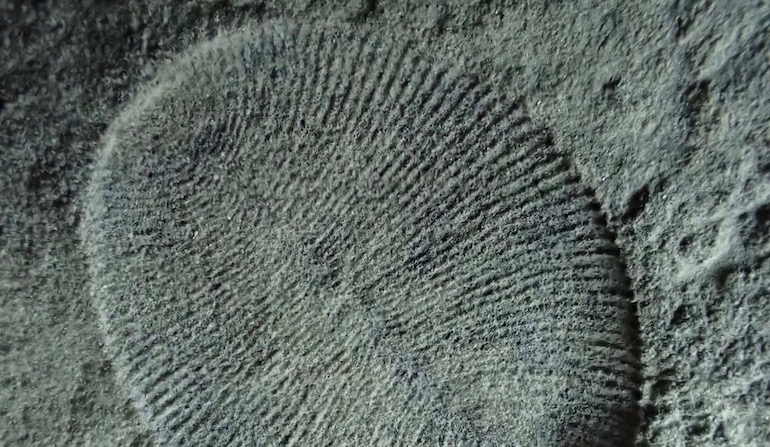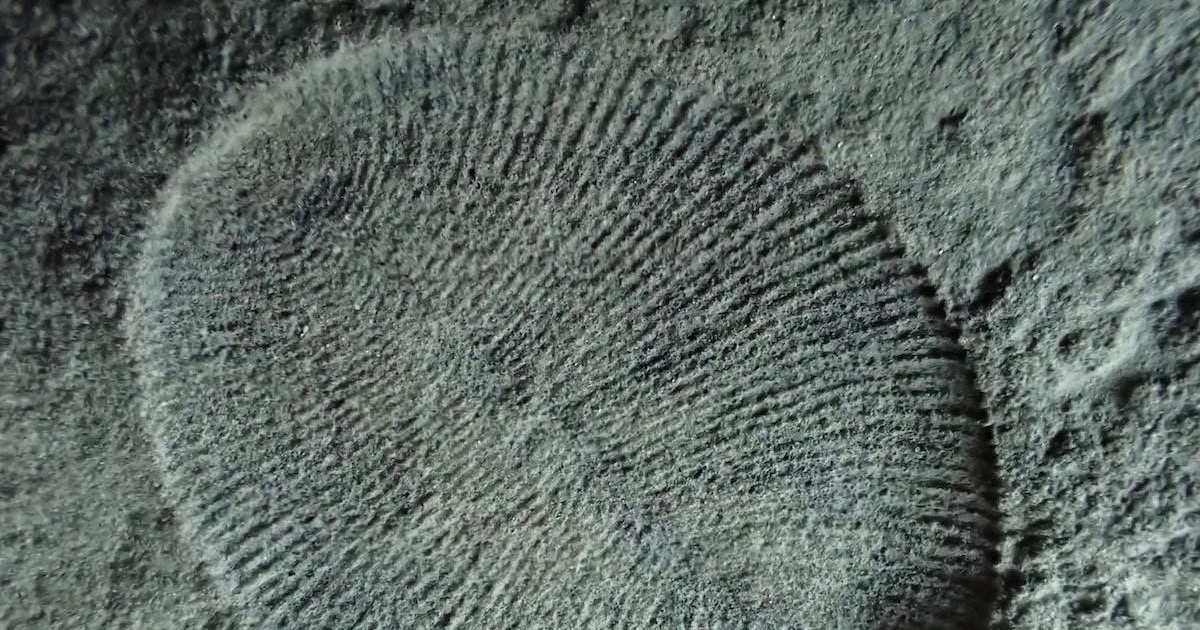 Evolution
Evolution
 Intelligent Design
Intelligent Design
A Thousand Dickinsonia Specimens Don’t Change the Ediacaran Story


Dickinsonia is one of the enigmatic creatures classed in the Ediacaran biota, a group of Precambrian macrofossils taking its name from the type section in the Ediacaran hills of South Australia. Growing from an inch to several feet long, this air-mattress-like creature has been variously interpreted as anything from a fungus to an animal, according to Stephen Meyer in Darwin’s Doubt (see Figure 4.1 on p. 80).
Most paleontologists have concluded, Meyer says, that whatever it was, Dickinsonia was not an ancestor to the bilaterian animals that appeared in the Cambrian explosion, having lacked the essential traits that characterize bilaterians, such as a head, gut, sensory organs, or limbs (see pp. 81-86). It’s not even clear that it has bilateral symmetry at all, or the triploblastic structure (three distinct tissue layers; see p. 93) characteristic of true animals.
Three researchers from the University of California, Riverside, went to Australia and examined a thousand specimens of Dickinsonia. Did they find anything to change its status as a possible ancestor? The spin-prone NASA rag Astrobiology Magazine tries to make it seem so, announcing “New Study Sheds Light on Earth’s First Animals.” They include a large color picture of the creature.
More than 550 million years ago, the oceans were teeming with flat, soft-bodied creatures that fed on microbes and algae and could grow as big as bathmats. Today, researchers at the University of California, Riverside are studying their fossils to unlock the secrets of early life.
In their latest study, published today in the journal PLOS ONE, Scott Evans, a graduate student in the Department of Earth Sciences, and Mary Droser, a professor of paleontology, both in UCR’s College of Natural and Agricultural Sciences, show that the Ediacaran-era fossil animal Dickinsonia developed in a complex, highly regulated way using a similar genetic toolkit to today’s animals. The study helps place Dickinsonia in the early evolution of animal life, and showcases how the large, mobile sea creature grew and developed. [Emphasis added.]
But what the article asserts in these opening paragraphs, it undermines at the end, showing that Dickinsonia could not have been in the evolutionary chain to the phyla that appeared in the Cambrian explosion (530-525 million years ago). They conclude:
The study showed that Dickinsonia’s development, and particularly that of the modules, was complex and systematic to maintain the oval shape of the animal. The accumulation of new modules, by a process called terminal addition, suggests that Dickinsonia developed in a related way to bilaterians, a complex group that display bilateral symmetry, including animals ranging from flies and worms to humans. However, the researchers do not believe Dickinsonia was ancestrally related to bilaterians, since it lacked other features that most bilaterians share, most notably a mouth, gut and anus.
“Although we saw some of the hallmark characteristics of bilateral growth and development, we don’t believe Dickinsonia was a precursor to today’s bilaterians, rather that these are two distinct groups that shared a common set of ancestral genes that are present throughout the animal lineage,” Evans said. “Dickinsonia most likely represents a separate group of animals that is now extinct, but can tell us a lot about the evolutionary history of animals.”
What can it tell about the evolutionary history of animals, however, if it (1) was not a precursor, (2) lacked the notable features of bilaterian animals, and (3) grew by “terminal addition” of new modules? Snowflakes and bubble mats can do that. Let’s see if the paper in PLOS ONE can shed any more light.
The Ediacara Biota represents the oldest fossil evidence for the appearance of animals but linking these taxa to specific clades has proved challenging. Dickinsonia is an abundant, apparently bilaterally symmetrical Ediacara fossil with uncertain affinities. We identified and measured key morphological features of over 900 specimens of Dickinsonia costata from the Ediacara Member, South Australia to characterize patterns in growth and morphology. Here we show that development in Dickinsonia costata was surprisingly highly regulated to maintain an ovoid shape via terminal addition and the predictable expansion of modules. This result, along with other characters found in Dickinsonia suggests that it does not belong within known animal groups, but that it utilized some of the developmental gene networks of bilaterians, a result predicted by gene sequencing of basal metazoans but previously unidentified in the fossil record. Dickinsonia thus represents an extinct clade located between sponges and the last common ancestor of Protostomes and Deuterostomes, and likely belongs within the Eumetazoa.
Did they find genes? No. Did they observe developmental gene networks? No. Did they find “stomes” (mouths) on these creatures? No. The connection to Protostomes (first mouth) and Deuterostomes (two mouths) is all inference. They had nearly a thousand of these creatures to look at, and only inferred that they lie somewhere between sponges and animals. And yet they admit that whatever Dickinsonia was, it went extinct.
Droser et al. place this creature within “an extinct lineage that split somewhere between sponges and the LCA [last common ancestor] of Protostomes and Deuterostomes,” meaning that it really has nothing to do with animals, which without exception have a mouth. For a transitional form, Dickinsonia is a pretty sad contender.
The highly regulated growth of Dickinsonia, along with features such as posterior addition, bilateral symmetry and organization around an anterior-posterior axis are characteristics found in bilaterians. However, most bilaterians are triploblastic and have a through gut and there is no evidence for the number of tissue layers or the presence of a mouth, anus or any type of gut in Dickinsonia. Some highly derived modern bilaterians do not have a through gut and many studies have demonstrated the importance of the secondary loss of characters in phylogenetic reconstructions, but it is unlikely that Dickinsonia is highly derived and our results suggest that it does not have the suite of characters necessary to be considered a crown group bilaterian.
If they had a better contender, they surely would offer it up. They do mention Kimberella as an incipient mollusk, and Helminthoidichnites as a hopeful bilaterian, acknowledging Graham Budd’s criticisms (Meyer, p. 85). But after combing through a thousand of these air mattress lookalikes, they can’t even bring themselves to postulate that Dickinsonia was a more complex (“derived”) animal that lost traits.
The only feature they try to attribute to evolution is apparent “highly regulated growth” of the organism to maintain its ovoid shape as it grows. But you can’t watch fossils grow, so that’s an inference, too. Nor can you watch fossils move, as they claim it did (again, by inference only, based on the slight difference between front and back ends). There’s no clear evidence of a second tissue layer, let alone a third. And they can’t even call the repeated structures “segments” which would presage a worm of some type. They call them “modules” instead. But do these modules really show a pattern of “highly regulated growth” and development?
We therefore conclude that the number of modules is not solely determined by overall size and that similarly sized specimens can have vastly different module numbers. The reasons for large differences in module number between specimens may simply be random…. This suggests that there was likely little functional significance in maintaining a specific number of modules with respect to size and highlights that conserving an ovoid shape and consistent length to width ratio was critical for D. costata.
What about the creature’s anatomy? Earlier reports “have suggested that Dickinsonia possessed complex internal structures,” but that idea got shot down, too:
No evidence for internal structures was observed in any specimens analyzed herein. All previous reports of features such as a through gut are likely due to deformation or the draping of Dickinsonia over irregular features present on the Ediacaran seafloor.
Perhaps that rules out claims of locomotion as well. We don’t see any evidence that Dickinsonia did much at all but sit there on the ocean floor. And if it grew, it didn’t grow like any other animal we know:
The plasticity of module number with respect to overall size between specimens of D. costata, despite the tight regulation on modular growth, suggests that module number is not a reliable proxy for age and that different specimens add and inflate modules at variable rates. This suggests that growth in Dickinsonia is fundamentally different from that of truly segmented animals.
We are not currently aware of any modern or extinct organism, segmented or otherwise, that grows in the same manner as D. costata. Any convergence between the growth of D. costata and modern organisms would likely reflect the importance of maintaining an ovoid shape and not phylogenetic ancestry.
Whatever similarities this creature might have had to other organisms, living or extinct, they chalk up to a familiar Darwinian magic wand, “convergent evolution.” It’s just out there, unique, distinct, unrelated — and extinct.
By the way, the paper never mentions a “genetic toolkit” that the NASA article bragged about. The authors only suggest that if the creature grew in a predictable way, it must have had “gene regulatory networks” like animals have. But if it did, it got those by convergent evolution, too, since it wasn’t on the line to the Cambrian animals.
In short, Dickinsonia doesn’t change the situation with the Cambrian explosion. We wonder if those putting out the money for this study are pleased with these pitiful results (the authors received funds from the NSF, NASA, National Geographic, and half a dozen other institutions). It’s worth knowing more about these creatures, but they don’t seem to offer any consolation for Darwinists.
The authors end by stating that more studies will be needed on other Ediacaran creatures in order “to gain further insight into the evolutionary history of early animals.” Translation: More funding, please. Meanwhile, Steve Meyer’s challenge stands.
Image: Dickinsonia tenuis, by Masahiro Miyasaka (Own work) [CC BY-SA 4.0], via Wikimedia Commons.
